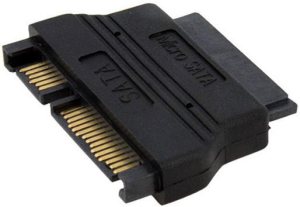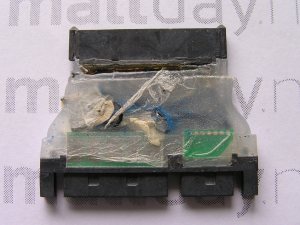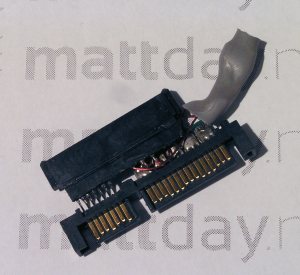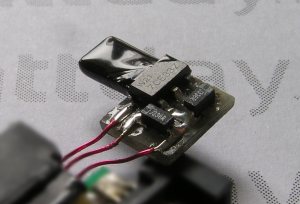Micro SATA Adapter
 1
1 2
2![]() 3
3![]() 4
4 5
5 6
6 7
7
Micro SATA: this is generally only found on 1.8" disk drives because these lack space for a regular-size SATA connector. The data connector is identical to the normal 7-pin SATA data connector, but a smaller 9-pin power connector replaces the usual 15-pin connector. The reduction of pins comes mainly from the absence of a 12V rail. There also exists a slimline connector. This has only 6-pins due to omission of the 3.3V supply as well. Check Wikipedia for the details.
Very soon after getting my Compaq Mini 311, I replaced the slow 2.5" mechanical disk with a 1.8" SSD. A micro SATA adapter of the type shown in (1) was bought for this purpose. In early 2010 there was not much choice here, with every other cheap micro SATA adapter looking exactly the same. I suspected it might be too big for installing a 1.8" disk in a 2.5" space, and it turned out it was.
Because I didn't want to buy another, I proceeded to hack the adapter to shrink it. The plastic/rubber cover slid off a bit too easily to reveal the mass of silicone in (2) and (3). I tried to pick this away to leave the wiring intact, although (4) shows that was not entirely successful.
The IC in the top left of (4) is a 3.3V linear voltage regulator. This suggests the adapter was originally designed with laptops in mind. Laptops often only have a 5V supply to the hard disk (as was the case for my 311 netbook). Most 2.5" drives only require 5V, so the 3.3V and 12V supplies found on a desktop power connector are left unconnected. The Intel X18-M SSD runs off 3.3V, so this regulator is essential. There is also a small surface mount capacitor connected to the output of the regulator, hidden under the masking tape in (4).
So anyhow, I discarded the small circuit board on the data connector and soldered the data pins on the regular-size SATA connector directly to those on the micro SATA connector. I replaced the power wiring with some solid core varnished stuff, and encapsulated both the regulator and capacitor in some heatshrink tubing. This produced the more compact adapter in (5). It got the job done, albeit with some maintenance required over the 2+ years of service. The first issue occured two or three times due to the strain forces on the tiny solder joints which linked the data pins. These had a tendency to separate, particularly if ever the SSD was removed and temporarily installed in a desktop machine. This issue was straightforward to fix, although after the voltage regulator stopped working for the 2nd time, it was clear the adapter needed reworking.
Solving the problem of the connections breaking was achieved trivially via epoxy. For the voltage regulator, I checked the data sheets for the X18-M and the 1117 regulator, and noted it should have been more than adequate. I decided to replace the output capacitor, add an input capacitor (as all regulator datasheets recommend) and heatsink the regulator to the PCBs copper. The tab on the 1117 is connected to the output voltage, so to avoid the possibility of shorts I dipped it in some black engine lacquer. The improved adapter is in (6), with a close-up of the regulator board in (7). ![]()
